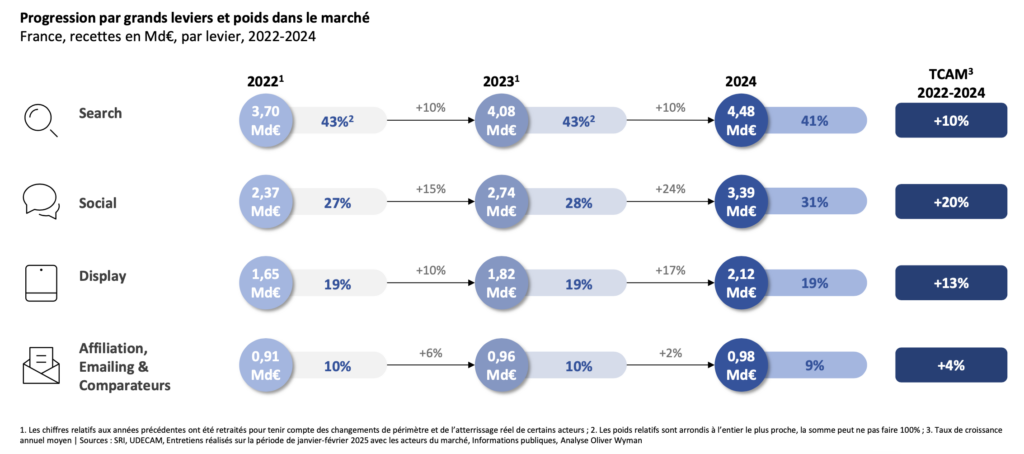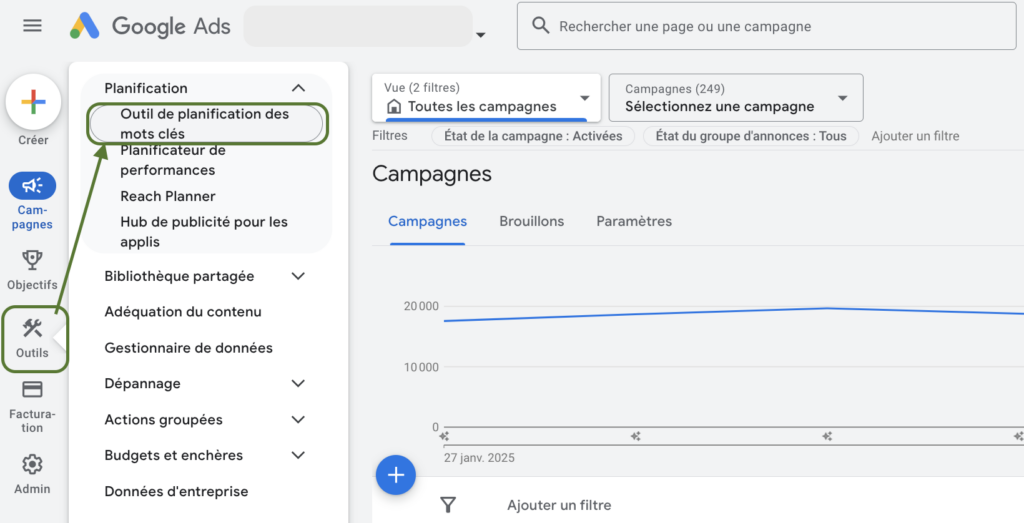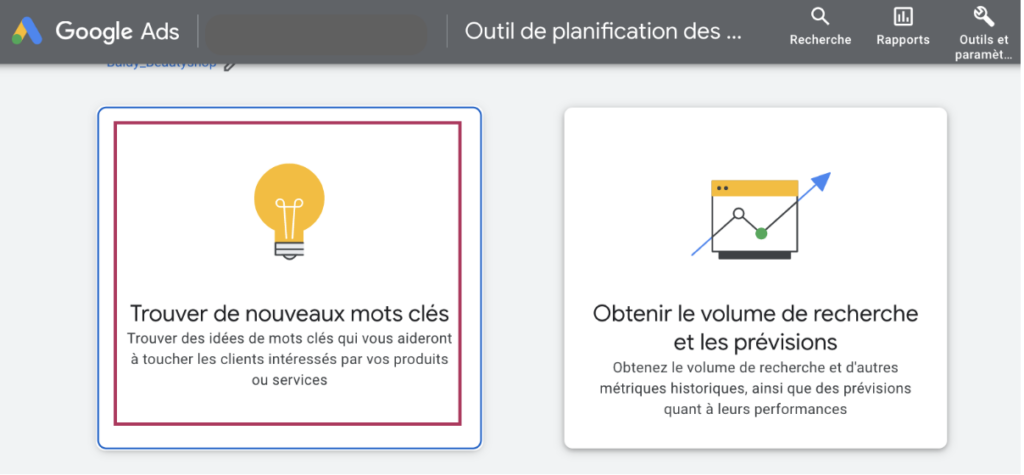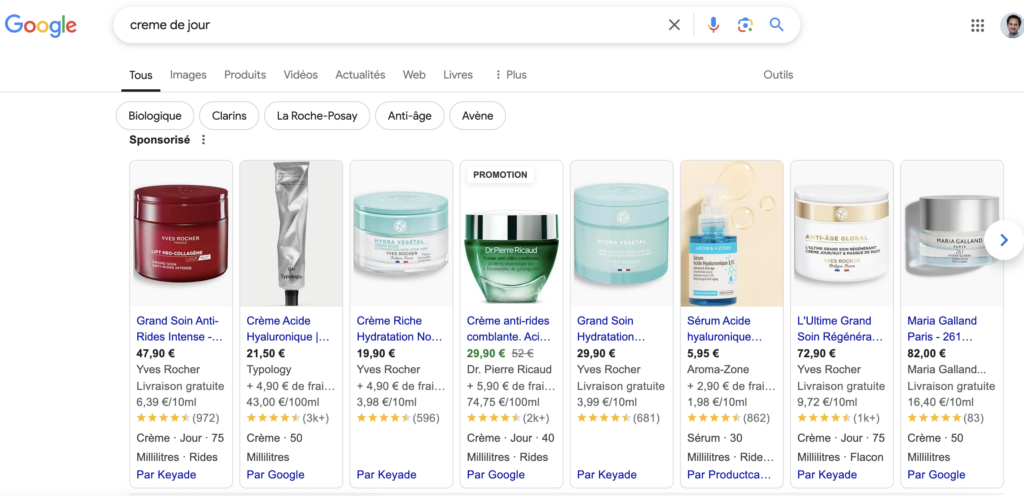simulate the results of your Google Ads campaigns:
Use our performance simulator to find out the expected results of your Google Ads campaigns.
Before getting to the heart of the matter, and giving you several keys to setting up your Google Ads budget, we feel it’s important to remind you of the state of the advertising market in France and around the world.
According to eMarketer forecasts in its “Worldwide Digital Ad Spending 2023” report, digital advertising spend will grow by 10.5% worldwide in 2023.
Thisgrowth also means that 67% of advertising budgets are now directed towards digital! For the first time this year, almost two-thirds of all advertising expenditure will be invested in digital.
67% of advertising spend is now on digital!
So how is investment in digital advertising distributed in France? And what weight does Google Ads have in advertisers’ budgets?
43% of web advertising spend will be on search in 2023, and 41% in 2024 (search engines).
We might as well tell you that this budget is allocated to Google, which is the favorite search engine of the French. In fact, Google holds 89.95% of the search engine market share, followed by Bing with 5.12%.
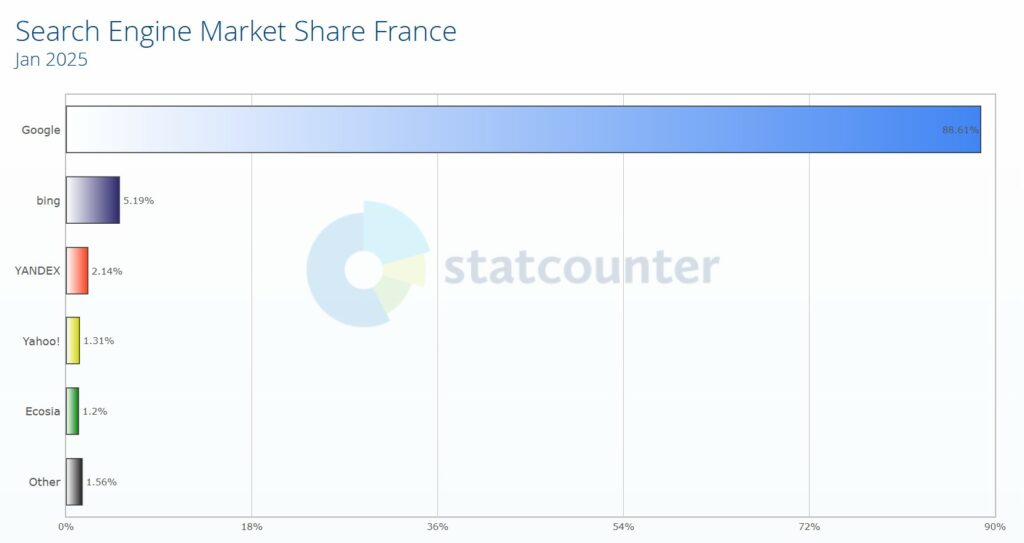
With this information on the state of the digital advertising market in France, you’re more or less in the clear about the breakdown of the Media Mix.
Now that you’ve done that, you know that your presence on Google is important and that you need to be visible on this channel, which will certainly bring you a lot of customers and constant sales.
If you need to estimate your Google budget: book an appointment with our Google Ads experts
With what budget? What indicators do you need to master and take into account? What are your objectives and how can you achieve them with Google Ads? And what do you need to analyze, track and improve when you launch your Google Ads campaigns ?
DEFINE YOUR OBJECTIVES FOR YOUR GOOGLE ADS CAMPAIGNS
Depending on the campaigns you run on Google Ads, you’ll be able to target different objectives: traffic, awareness, sales… and you’ll have access to different ad formats (text, display, shopping).
With the many tools and bidding strategies offered by Google Ads today, it can be difficult to decide how to set an effective budget for your campaign. After all, it’s important to remember that Google Ads works on a bidding system, which will help you ensure the visibility of your ads and reach your target.
For e-commerce, the objective is often to increase sales. A minimum return on advertising investment is expected (the famous ROAS) or a maximum customer acquisition cost (CAC = customer acquisition cost or CPA = cost per conversion).
We can even speak of an objective and a constraint.
The objective being sales growth and the constraint ROAS.
The second constraint in this case will be your daily budget, which will limit the distribution of your campaigns.
However, if your campaigns reach your sales targets while respecting your ROAS: there would theoretically be no reason to limit the budget for your campaigns since they are profitable.
The objective of your campaigns could simply be to attract more traffic to your website, or to increase the number of subscribers to your site.
And as you’ve understood, it all depends on your activity and your needs in terms of business and marketing.
ROAS (Return on Ad Spend) is a ratio that measures the return on investment of an advertising campaign.
It is calculated by dividing the total revenue generated by a campaign by the total cost of that campaign.
ROAS = Total revenue / Total campaign cost
Ex: You want to spend €100 on Google Ads and want it to earn you €1000. In other words, multiply your advertising investment by x10
In this case, you would like to obtain a ROAS of 10 (or 1000% in your Google Ads campaign parameters).
Which bidding strategy: ROAS vs CPA (CAC)
The CAC, “Customer Acquisition Cost”, is the value that represents the cost you’re willing to invest to acquire a customer on Google Ads.
It is calculated by dividing the total amount you spend on your campaign by the total number of conversions in that campaign.
CAC = Total costs / No. of conversions
In terms of management control, it is sometimes simpler to use the cost of acquiring a customer rather than ROAS, which requires knowledge of your margins and good segmentation of your campaigns.
In fact, your products do not all have the same margins, and consequently your campaigns should not have the same ROAS objectives.
With these objectives and constraints in mind, it’s time to make some simulations and estimates.
We’ll then look at which bidding strategy is best suited to your needs, and which solutions Google Ads offers to help you achieve them.
SET THE AMOUNT TO SPEND PER MONTH ON GOOGLE ADS
To set your budget, it’s always a good idea to use the Google Ads simulator. But you can also use competitive intelligence tools to situate yourself in relation to your competitors.
The keyword planning tool to simulate the cost of your Google Ads campaign and your monthly budget
The keyword keyword planning tool is a good starting point for estimating the traffic potential you can achieve through Google Ads campaigns.
The tool goes quite far. It offers you simulations by integrating your conversion values and the conversion rate of your campaign. It then calculates the result on your sales and the return on investment you’ll be able to achieve.
WARNING: this is a simulation! Reality is often very different from simulation.
Here’s the result of a simulation we ran. For the example, we searched for “baby strollers” and “compact strollers”.

In the simulation above, you’ll find the conversion rate (1%) and conversion value (200€) I’ve set.
The simulator tells me that with a daily budget of €110, my conversion value (or sales) could amount to €17k. That’s a ROAS of 5.6 and CPA (CAC) of 36€.
In this case, your monthly budget for this campaign would be €3,000 per month.
Once you’ve defined the monthly budget limits for your campaign, you’ll choose a campaign type that will show your ads. You can choose Shopping campaigns, Performance Max campaigns, Text campaigns with relevant keywords or the products you want to sell.
Don’t forget that your budget and spending on Google Ads depend on the bids you’re willing to put on a product or keyword.
Average CPC is the price at which you’ll acquire clicks on a given keyword or product on Shopping and Performance Max. The Max CPC is the maximum bid you’d like to set (in manual management).
This same cost-per-click (CPC) will vary according to the desired objective of your campaign. Generally speaking, it will be higher when you’re faced with a search from an Internet user whose intention is to buy your product.
Apart from campaigns whose bids are managed manually, it’s Google Ads’ automatic bidding strategies and Machine Learning that will apply the bid for your keywords or products.
And just what are the Google Ads automatic bidding strategies that will enable you to reach your objectives and control your daily expenses?
WHAT ARE GOOGLE ADS’ AUTOMATIC BIDDING STRATEGIES?
To achieve your goal, you’ll need to choose the right campaign type and bidding strategy. Here are the different strategies offered by Google Ads.
To help you choose your bidding strategy, let’s take the case of an e-commerce business that needs to display its products in Shopping format. In this case, its ads will be displayed as images (of the products) thanks to its product feed imported into Google Merchant Center.
Feel free to read our article on ROAS vs. target CPA , which will be a good complement to the information below.
In the example below, products are displayed using a Shopping Standard campaign or a Performance Max campaign.
Performance Max bidding strategies
Since the objective of an Ecommerce business is often to sell products, you can use 2 strategies:
Objective 1: Increase the number of Conversions with a CPA constraint (Cost per Acquisition, equivalent to CAC: customer acquisition cost)
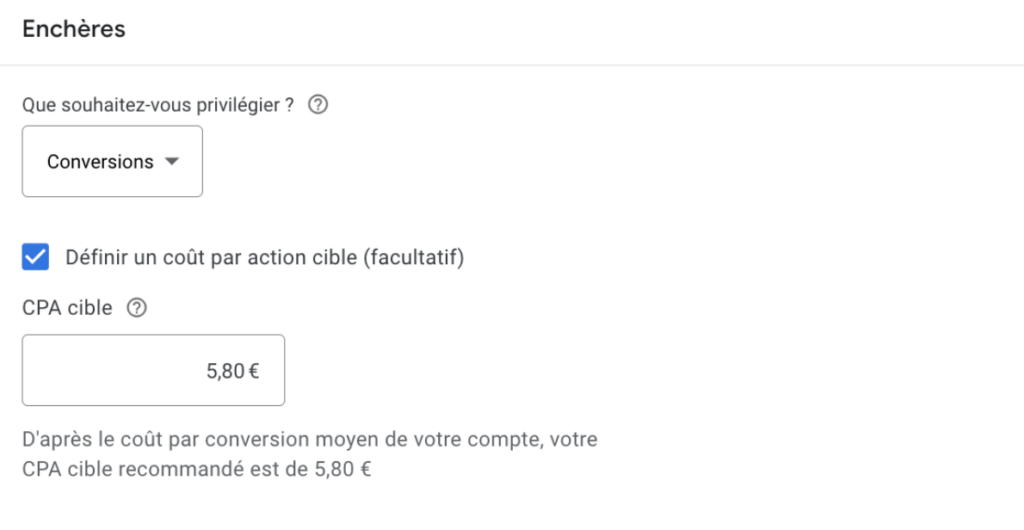
Objective 2: Increase conversion value with a ROAS constraint
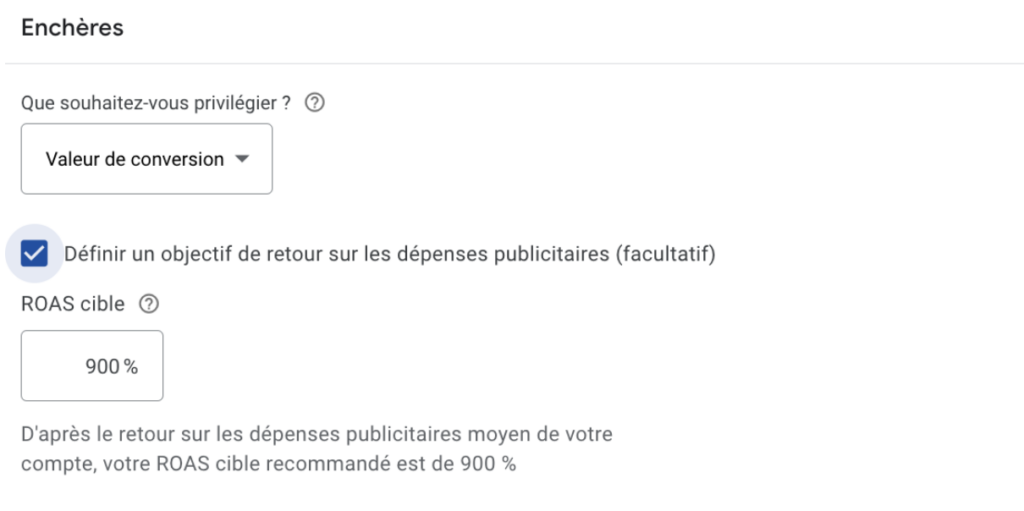
Google Shopping Standard bidding strategies
We talk about them here to illustrate bidding strategies, but you should know that it’s not (anymore) this type of campaign that we recommend for Ecommerce, but rather Performance Max campaigns.
With Shopping Standard campaigns, you’ll be able to exploit 3 bidding strategies:
1. Target ROAS: The automatic bidding strategy with a target ROAS
2. Maximize Clicks: The automatic bidding strategy to maximize clicks and therefore traffic to your site
3. Manual bidding: the manual bidding strategy where you control the bidding manually
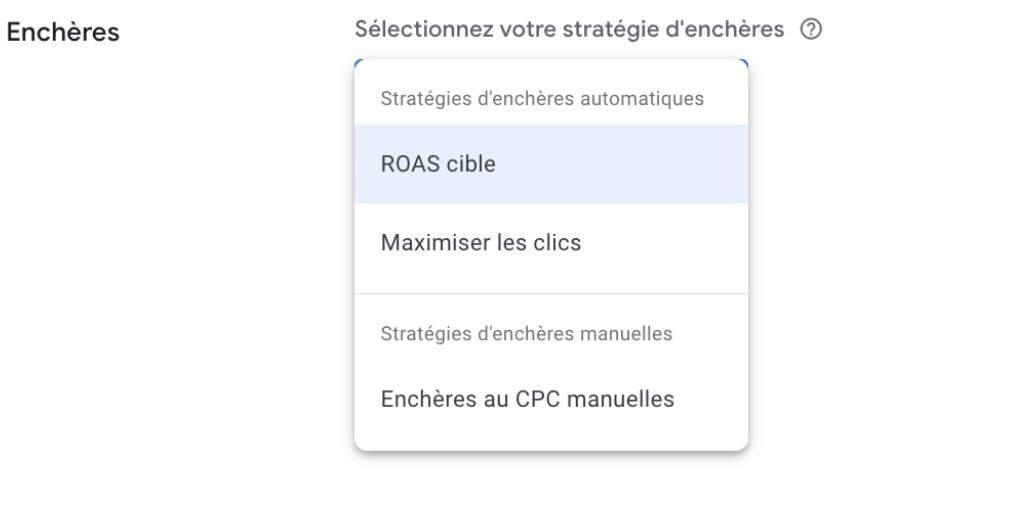
Bidding strategies for text ads on the Search Network
For Google Ads’ historical text ads, bidding strategies have also been automated to help you reach your objectives:
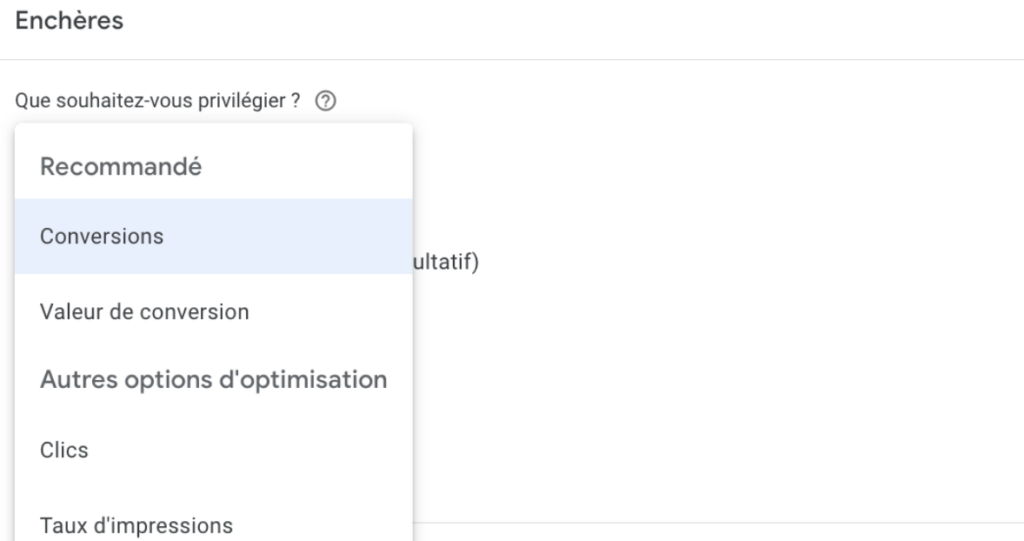
Above are the 4 bidding strategies you can implement for your ads on the Search Network and your text ads:
1. Conversion: Like the automatic Performance Max strategies, this involves increasing the number of Conversions with a CPA constraint (Cost per Customer Acquisition)The automatic auction strategy with a target ROAS
2. Conversion value: The same applies to conversion value (increasing your sales) with a ROAS constraint.
3. Clicks: this option allows you to obtain a volume of traffic with an optional maximum bid constraint.
3. Impression rate: This option ensures the visibility of your ad on the search engine.
You therefore have a choice of strategies, while limiting your daily budget and “imposing” a constraint of Return on Investment or customer acquisition cost.
In this way, Google Ads’ algorithms will be able to assign the right bid to your campaigns and ads so that you get enough visibility and meet your chosen objective.
Magic doesn’t always happen, and your competitors are there to remind you. That’s why you need to monitor and analyze your campaigns on a regular basis. Which brings us to the last part of this article: Measuring and monitoring your performance indicators.
MEASURE THE PERFORMANCE OF YOUR GOOGLE ADS CAMPAIGNS
Measuring and tracking the key indicators of your campaigns is a recurring and important management task. Fluctuations in traffic, conversions and external events are all factors that need to be taken into account if you are to achieve your objectives.
Once you’ve set your budget, chosen your campaign type and adjusted your bidding parameters, you’ll need to monitor its performance.
In addition, it will be important to understand how to maintain your performance over time.
Here are a few tips:
- Set up Reports on your Google Ads account or use Data Studio.
- Analyze your historical data to gain a better understanding of past performance and predict future trends.
- Use Google Analytics to track your site’s overall conversion rate and your visitors’ behavior in order to improve their experience.
- A/B test your campaigns.
- Monitor and anticipate peak traffic periods and the seasonal nature of your business.
- Keep an eye on your competitors.
- Set up sales events and promotions.
CONCLUSION
Setting a budget for your Google Ads advertising campaigns largely depends on your objectives and the type of products and services you offer.
Knowing your financial indicators and constraints, such as the maximum cost of acquiring a customer or the target ROAS of your campaigns, is essential for good management and allocation of your budgets.
Your Cost of Customer Acquisition or Return on Advertising Investment depends on your bidding strategy and the average cost per click (CPC) of your keywords or products on Google Shopping. Mastering these components will help you achieve your objectives.
You’ll need to monitor the overall performance of your account and the campaigns you’ve created, so that you can react according to the results, but also to the market (yes, you’re not alone, and the competition is fierce).
Finally, by tracking your historical data and implementing a testing and optimization strategy, you can maintain the effectiveness of your Google Ads campaign over the long term.
Don’t hesitate to contact us if you need an update on your Google Ads strategy and budget allocation.
Need to evolve your digital strategy?
We carry out a complete diagnosis of your strategy and campaigns.
Fully supported by Adenlab, you pay nothing.
Our free preliminary audit will give you a clear picture of the current state of your campaigns. It will enable you to identify and plan the evolution of your performance on your acquisition channels.

